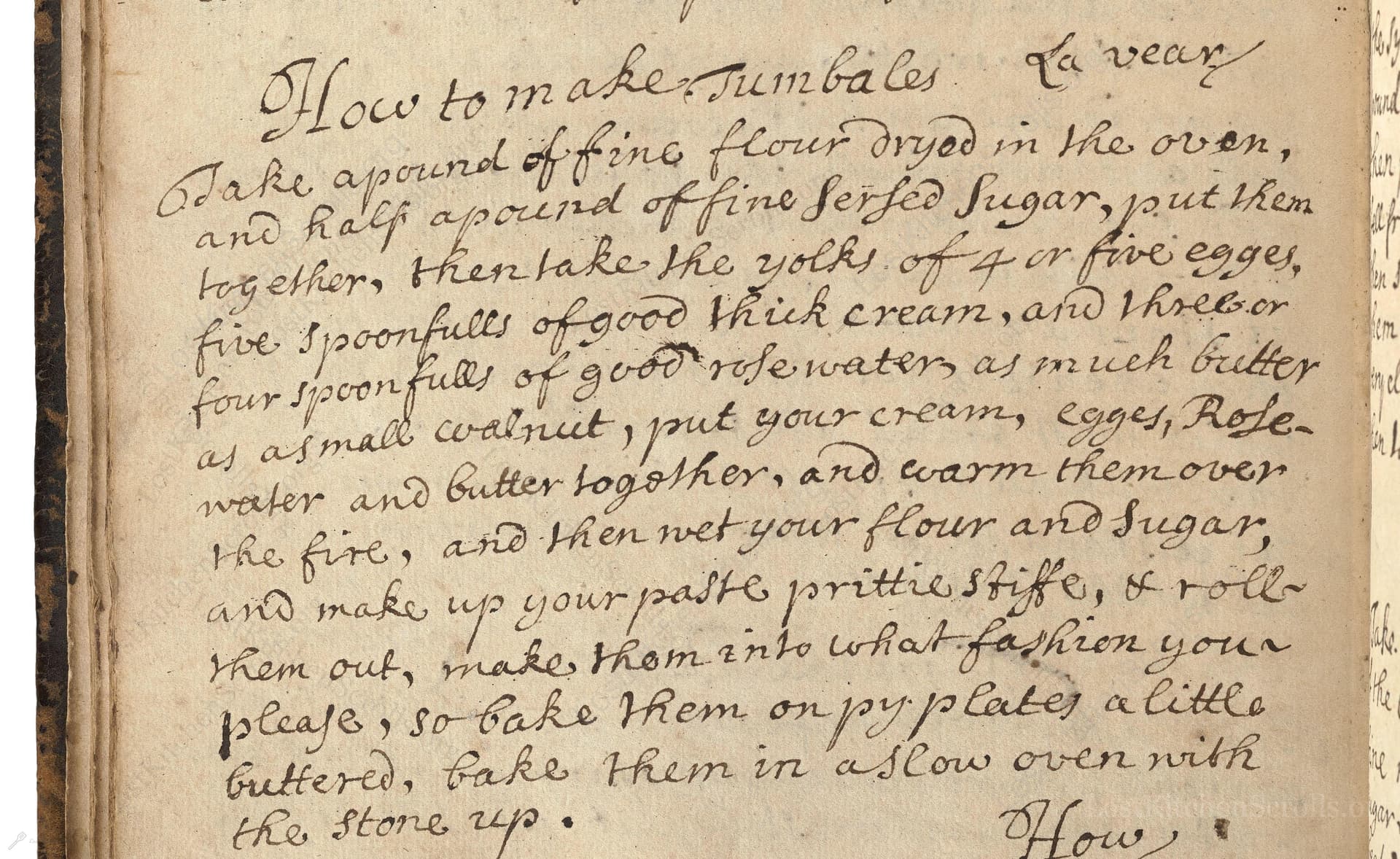How To Make Jumbals La Vear
From the treasured pages of Cookbook
Unknown Author

How To Make Jumbals La Vear
"Take a pound of fine flour dryed in the oven, and half a pound of fine serfed Sugar, put them together, then take the yolks of 4 or five egges, five spoonfulls of good thick cream, and three or four spoonfulls of good rosewater, as much butterr as a small walnut, put your cream, egges, Rose-water and butterr together, and warm them over the fire, and then wet your flour and Sugar, and make up your paste prittie stiffe, & roll them out, make them into what fashion your please, so bake them on py plates a little butterred, bake them in a slow oven with the stone up."
Note on the Original Text
The original recipe is a model of its time: it relies on the cook’s experience, providing no oven temperatures or times, and uses approximations like 'as much butter as a small walnut'. The spelling reflects early 18th-century norms: 'py plates' means pie plates or baking trays, and 'serfed' size means sieved or finely sifted sugar. The phrase 'with the stone up' refers to a cool, slow oven, essential for baking sweet, delicate doughs evenly without browning. Such instructions required an intimate familiarity with kitchen tools and techniques of the era.

Title
Cookbook (1706)
You can also click the book image above to peruse the original tome
Writer
Unknown
Era
1706
Publisher
Unknown
Background
Step back to the early 18th century with this charming culinary collection, brimming with period recipes that tantalize the tastebuds and offer a delicious glimpse into historic kitchens.
Kindly made available by
Folger Shakespeare Library
This recipe for Jumbals comes from an English manuscript dated approximately 1706, a time when biscuits and sweet baked goods were gaining popularity among the upper and aspiring middle classes. Jumbals were prized for their firm texture, delicate shape, and aromatic flavor, often served with tea or as a genteel treat. The use of rosewater reflects the period’s fascination with perfumed sweets, and the method echoes a transitional phase in British baking, bridging medieval spiced confections and modern biscuits. Recipes like this were often passed among households, catering to those with access to sugar, eggs, and imported luxury flavors.

In the 18th century, the cook would use a large wooden bowl, a sturdy wooden spoon or hands for mixing, and an earthenware or tin baking tray (py plates) greased with butter. Eggs and cream would be gently warmed over a low fire, likely in a small pan. The paste was rolled out with a wooden pin and shaped by hand or with basic cutters. Baking occurred in a brick or stone oven, with the reference to 'the stone up' indicating a cool, gentle heat ideal for slow baking delicate pastries.
Prep Time
25 mins
Cook Time
25 mins
Servings
16
We've done our best to adapt this historical recipe for modern kitchens, but some details may still need refinement. We warmly welcome feedback from fellow cooks and culinary historians — your insights support the entire community!
Ingredients
- 1 lb plain white flour (dried in a low oven)
- 8 oz caster sugar (substitute for 'fine serfed sugar')
- 4-5 egg yolks (from large eggs)
- 5 fl oz double cream (thick cream)
- 2 fl oz rose water (culinary grade; or use less, mixed with water, for subtler flavor)
- 1 oz unsalted butter
- Extra butter for greasing (as needed)
Instructions
- To make Jumbals (La vear) in your modern kitchen, begin by weighing out 1 lb of plain white flour and drying it in the oven for several minutes to mimic historical flour's lower moisture.
- Sift together with 8 oz of caster sugar.
- Gently warm the yolks of 4-5 large eggs, 5 fl oz of thick double cream, 2 fl oz rose water, and about 1 oz unsalted butter (approximate size of a small walnut) in a saucepan until just combined and the butter melts.
- Pour the warm mixture into the flour and sugar.
- Mix until a stiff dough forms—add a splash more cream if needed.
- Turn onto a floured surface, roll out to about 3/8 inch thickness, and shape as you like (traditional knots, rings, or S-shapes).
- Place on a lightly buttered baking tray and bake at 300°F (fan 275°F) for about 20-25 minutes, or until just lightly golden but not brown.
- Cool on a rack.
Estimated Calories
220 per serving
Cooking Estimates
Preparing the dough, shaping, and baking takes about 50 minutes in total. Each serving has about 220 calories if you make 16 biscuits from this recipe.
As noted above, we have made our best effort to translate and adapt this historical recipe for modern kitchens, taking into account ingredients nowadays, cooking techniques, measurements, and so on. However, historical recipes often contain assumptions that require interpretation.
We'd love for anyone to help improve these adaptations. Community contributions are highly welcome. If you have suggestions, corrections, or cooking tips based on your experience with this recipe, please share them below.
Join the Discussion
Rate This Recipe

Den Bockfisch In Einer Fleisch Suppen Zu Kochen
This recipe hails from a German manuscript cookbook compiled in 1696, a time whe...

Die Grieß Nudlen Zumachen
This recipe comes from a rather mysterious manuscript cookbook, penned anonymous...

Ein Boudain
This recipe comes from an anonymous German-language manuscript cookbook from 169...

Ein Gesaltzen Citroni
This recipe, dating from 1696, comes from an extensive anonymous German cookbook...
Browse our complete collection of time-honored recipes



